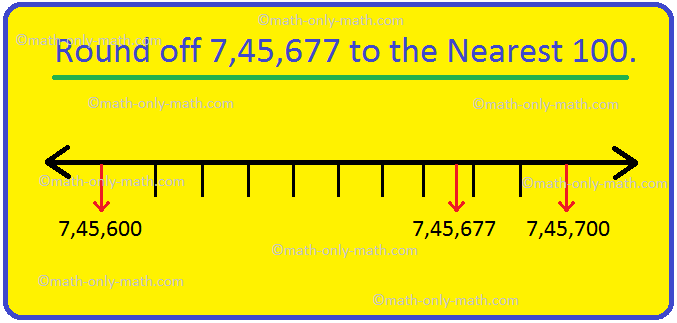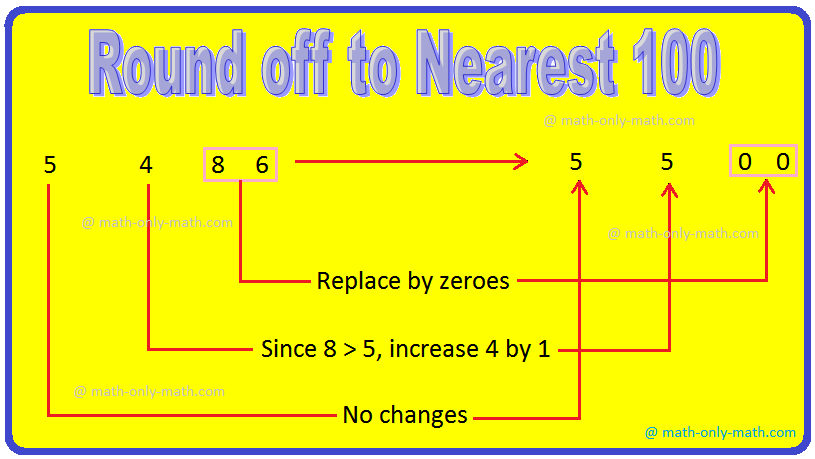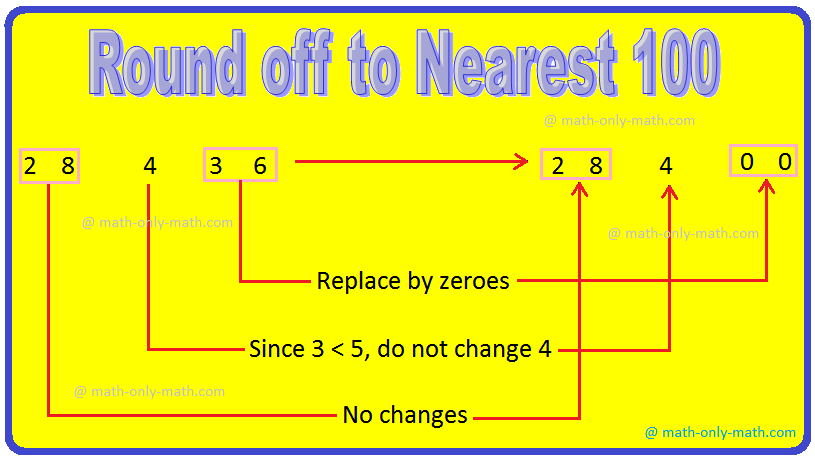Subscribe to our ▶️ YouTube channel 🔴 for the latest videos, updates, and tips.
Round off to Nearest 100
In round off to nearest 100 we will learn how to round the number to the nearest hundred.
To round off a number nearest to 100, look at the tens digit.
182 → 200
437 → 400
If the digit at the tens place is greater than 5, round off to the next 100.
If the digit at the tens place is less than 5, round off to the existing 100.
For example,
• 502 can be rounded to 500.
• 669 can be rounded to 700.
Rules for Rounding off to the Nearest 100:
Rule I: While rounding off to the nearest hundred, if the digit in the tens place is between 0 – 4 i.e. < 5, then the tens place is replaced by ‘0’.
Rule II: If the digit in the units place is equal to or > 5, then the tens place is replaced by ‘0’ and the hundreds place is increased by 1.
Round off to Nearest 100 Video
Subscribe to our ▶️ YouTube channel 🔴 for the latest videos, updates, and tips.
Examples on rounding off to the nearest hundred (100):
1. (i) 142 → 100
We see the digit in the tens place is 2, we round to the nearest multiple of hundred which is less than the number. Hence, 142 is nearer to 100 than 200.
(ii) 486 → 500
We see the digit in the tens place is 8, we round to the nearest multiple of hundred which is greater than the number. Hence, 486 is nearer to 500 than 400.
(iii) 799 → 800
We see the digit in the tens place is 9, we round to the nearest multiple of hundred which is greater than the number. Hence, 799 is nearer to 800 than 700.
(iv) 4387 → 4400
We see the digit in the tens place is 8, we round to the nearest multiple of hundred which is greater than the number. Hence, 4387 is nearer to 4400 than 4300.
(v) 950 → 1000
We see the digit in the tens place is 5, we round to the nearest multiple of hundred which is greater than the number. Hence, 950 is nearer to 1000 than 900.
2. Round off 7,45,677 to the nearest 100.
Solution:
We choose the two multiple of 100 just greater than and just less than 7,45,677 on the number line.
We observe that 7,45,677 is closer to 7,45,700. So, it is rounded down to 7,45,700.
Round off to Nearest 100
Step I: Replace ones and tens digits by zeroes.
Step II: If tens digit is 5 or more than 5, increase the hundreds digit by 1, otherwise do not change.
Step III: Leave rest of the digits unchanged.
3. Round off to the nearest hundred: 5486
4. Round off to the nearest hundred: 28436
5. Round off (i) 243, (ii) 1887 to the nearest 100.
Solution:
(i) 243 is rounded off to 200 because the digit at the tens place is 4.
(ii) 1887 is rounded off to 1900 because the digit at the tens place is 8.
6. Round off to the nearest 100:
(i) 4536; (ii) 368
Solution:
(i) We have to round off 4536.
Therefore, 4536 is rounded off to 4500.
(ii) We have to round off 368.
Therefore, 368 is rounded off to 400.
Worksheet on Round off to Nearest 100:
1. Round off the following 3-digit numbers to the nearest 100.
(i) 112
(ii) 181
(iii) 497
(iv) 568
(v) 239
(vi) 909
(vii) 740
(viii) 516
(ix) 380
(x) 445
Answer:
1. (i) 100
(ii) 200
(iii) 500
(iv) 600
(v) 200
(vi) 900
(vii) 700
(viii) 500
(ix) 400
(x) 400
2. Round off the given numbers to nearest 100.
(i) 3,398
(ii) 39,872
(iii) 6,201
(iv) 19,661
(v) 15,449
(vi) 82,069
(vii) 1,00,678
(viii) 19,32,208
Answer:
2. (i) 3,400
(ii) 39,900
(iii) 6,200
(iv) 19,700
(v) 15,400
(vi) 82,100
(vii) 1,00,700
(viii) 19,32,200
3. Round off to the nearest hundred:
(i) 625
(ii) 42753
(iii) 2876
(iv) 67527
(v) 3456
(vi) 1281
Answer:
3. (i) 600
(ii) 42800
(iii) 2900
(iv) 67500
(v) 3500
(vi) 1300
4. Round the following numbers to the nearest hundreds:
(i) 127
(ii) 351
(iii) 726
Answer:
4. (i) 100
(ii) 400
(iii) 700
5. Round 2698 to the nearest hundreds.
Answer:
5. 2700
6. An author sold 45,379 copies of book. For the newspaper report, the figure was rounded to nearest 100. What was the figure given in the newspaper?
Answer: 45,400
How to round off a number to the nearest 100?
How to round off a number to the nearest 100?
Answer
To round off a number to the nearest hundred, look at the digit in the tens place.
• If the digit in the tens place is 4 or less, then place zeroes in the tens and ones place. The digit in the hundreds place remain the same.
• If the digit in the tens place is 5 or more, then place zeroes in the tens and ones place. Add 1 to the digit in the hundreds place.
- Round off to Nearest 10.
- Round off to Nearest 100.
- Round off to Nearest 1000.
- Rounding off Decimal Fractions.
- Correct to One Decimal Place.
- Correct to Two Decimal Place.
- Worksheet on Rounding off number.
5th Grade Math Problems
From Round off to Nearest 100 to HOME PAGE
Didn't find what you were looking for? Or want to know more information about Math Only Math. Use this Google Search to find what you need.







New! Comments
Have your say about what you just read! Leave me a comment in the box below. Ask a Question or Answer a Question.